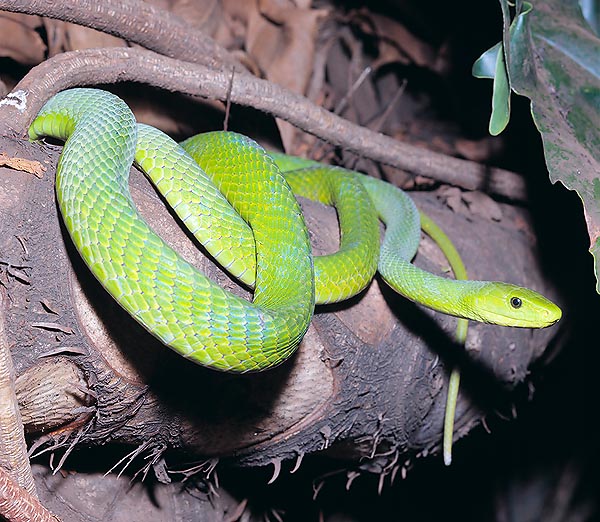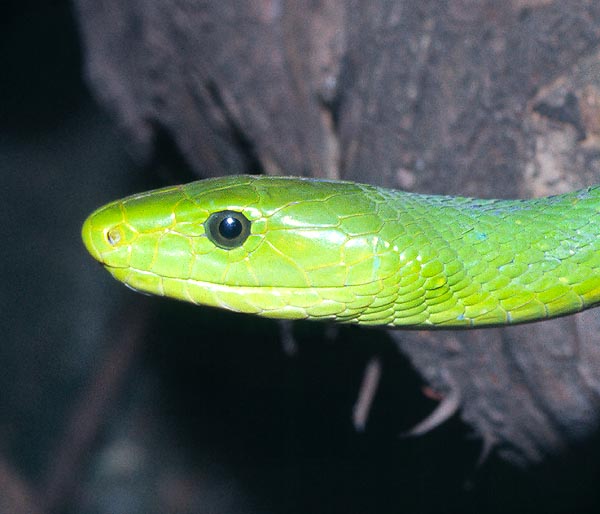Family : Elapidae

Text © Dr. Gianni Olivo

English translation by Mario Beltramini
The Eastern green mamba (Dendroaspis angusticeps Smith, 1849, family (Elapidae), together with the other two green mambas (Dendroaspis viridis and Dendroaspis jamesoni) deserves, more than the black mamba, its scientific name of arboreal snake, as it spends most of its existence between the branches of the trees.
It is a serpent of remarkable size, reaching the length of 250 cm in the biggest specimens, whilst the average of the adults stands between the 160 and 200 cm. Against a considerable length, however, its diameter is somewhat modest and the overall look is that of an extremely graceful and elegant reptilian, helped in this, by its bright green colour.
The head resembles to that of the other mambas, that is to say, it is coffin-shaped, narrow and elongated, with the “cheeks”, using a word not fully correct, almost parallel. The eye has round pupil and the labial commissure goes well backward than the eye which is placed at almost half-way between the apex of the muzzle and the labial corner. As I said, the colour is bright green, at times with some paler scale which creates a sparse pitting, the ventral part is paler, and whilst the unripe specimens have a paler green colour at times close to yellow, but such colouration is present only till when the animal reaches the 60 cm.
As soon as out from the egg, the hatchling is 30 to 40 cm long and is already in condition to inoculate a dose of venom potentially fatal to humans. The number of rows of scales by the mid length of the body goes from 17 to 19. The tail is long and thin and the passage body-tail is not evident.
The venomous fangs, placed forward on the palate, fixed (proteroglyphous), are 5 to 7 mm long and in good part covered by a mucosal sheath which is pushed back by the pressure when the animal is biting.

The Green mamba (Dendroaspis angusticeps) is one of the most feared African snakes © Giuseppe Mazza
Distribution and habitat
Many people tend to identify as green mamba every serpent of this colour the may see on the plants, for which the reports are often unreliable, so much that some times persons told me they had seen a green mamba in their garden or during an excursion, in a zone where this serpent is not present. The fact of being a mamba, synonym of deadly serpent, the green colour, strangely, from centuries, associated with malignance and poisonousness, in the serpents, the preference for the life on the plants, have fed wrong myths and rumours: many believe that the green mamba is more dangerous than the black mamba whilst its less nervous character, a less powerful venom and its retired life, render it much, but really much, less harmful than its cousin.
Others believe that this serpent stays swinging from the branches waiting to bite the unaware victim: this is not done even by the black mamba; at least, it does not do so with the aim of biting somebody, but surely, going to graze a black mamba which is staying on a branch along a footpath, results much easily in a violent reaction than what might happen with a green mamba.
For what the recognition of the reptilian we are talking of is concerned, and in order to avoid gross confusions, it is worthy to remind that a green arboreal serpent with smooth and not keeled scales, longer than 150 cm, cannot be anything else than a green mamba, even if the Boomslang (another highly venomous serpent and arboreal too), may reach the two metres. However, this last has keeled scales and “scabrous” look, very big eye, short and blunt muzzle and when upset it swells vertically its fore part, at the level of the neck. A common character for the two species is a certain reluctance to bite if not repeatedly provoked.
Going back to erroneous sightings in areas where it is not present, actually the range of distribution of the western green mamba is quite limited: coastal zones of Kenya (it is not reported further north), and some isolated enclave in the Kenyan hinterland, it is common in Tanzania in a coastal strip which, in the southern part, widens westward up to the northern part of Lake Malawi. It is present in Zimbabwe especially in some tea plantations and on the Chimanimani mountains range, and also in Malawi whilst is not reported in Zambia. It is absent in the northern part of Mozambique and this is rather odd as it seems almost that the boundary with Tanzania marks also the precise frontier to the presence of the green mamba, present north of Rovuma and absent south.
It reappears then in Mozambique more to the south, in the coastal strip and in a transversal belt going up to the Chimanimani Mountains (boundary with Zimbabwe). Even more to south, it is present in the Maputo area and then in South Africa (Kwa-Zulu), especially in the plantations along the Indian Ocean. There are then isolated enclaves (for instance on the slopes of Kilimanjaro and of the Mount Kenya, in the Usambara (Tanzania), in the Zanzibar Islands, Mafia and Pemba. Most probably, in the future, some new reliable report might happen also in unexpected areas, but, usually, the strip is really limited to an exiguous eastern strip.

Mamba round eyes and typical coffin shaped, narrow, elongated head with cheeks © Giuseppe Mazza
Its best habitats are the thick and not too dry bush, woody areas, plantations, and, often, gardens. It is not unusual that it installs close to a dwelling or a farm and it is quite common to find it in the characteristic thatched roofs. In the end, it prefers less open areas and thicker bush than the black mamba and in the areas where both species are present, the subdivision of the habitats is even more evident and clear.
Habits
Wonderfully adapted serpent to the life on trees and bushes, it goes down, however, to the ground, for moving from a wooded area to another and also, but more rarely, for capturing a prey (but this is a more theoretical than sure occurrence).
It moves on the ground as well as on the branches, with speed and agility and hunts, actively, birds, lizards, chameleons, tree frogs and small mammals and is a diligent predator of bats, which it surprises during the day, when they are inactive.
As a matter of fact, it is a reptilian mainly diurnal, and during the night it sleeps on a branch or in the hollow of a tree.
Oviparous reptilian, like all mambas, may lay up to 15 eggs, which are left abandoned to themselves and take about 90 days for hatching, often helped by the presence of decaying vegetal material which maintains some heat.
Attitude towards the man and venom
Unlike the black mamba, it is not an aggressive serpent, rarely it menaces mouth wide open and does not widen the narrow “hood” of the black mamba, and the interior of the mouth is clear, unlike the previous one. The poison is less studied than that of Dendroaspis polylepis, but it is known that it is less powerful, even if abundantly fatal for man. The lethal dose for an adult person is of about 18-20 mg vs. the 12-15 mg of Dendroaspis polylepis, whilst the dose it may inoculate with a bite is of 60-100 mg. For a comparison and for some characteristics of the toxins of the green mambas, please see the text concerning the black mamba.
The bites are rare, seen its shyness, elusiveness, and pacific temper, and concern mainly enthusiasts who handle serpents or, more rarely, the workers of the plantations, in case the put a hand directly on a reptilian. Among the few reported cases, in two at least were present local symptoms such as tumefaction, oedema and even necrosis, phenomena which do not occur with the venom of the black mamba.
After inoculation of polyvalent serum, usually, the resolutions of the symptoms is faster than after a bite of Dendroaspis polylepis, but often is in any case necessary the assisted ventilation and a bite of green mamba remains, surely, an emergency.
Common names: English: western green mamba, Common green mamba; Afrikaans: Groenmamba, Groen mamba; isiZulu: Imamba eluhlaza; Xhosa: Imamba.
→ For general notions about Serpentes please click here.
→ To appreciate the biodiversity within the SNAKES please click here.
